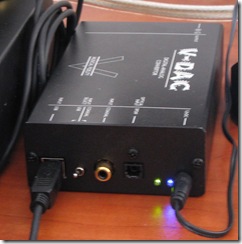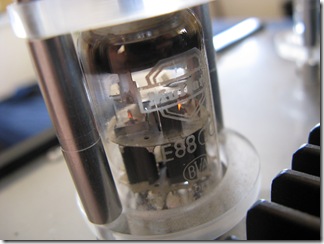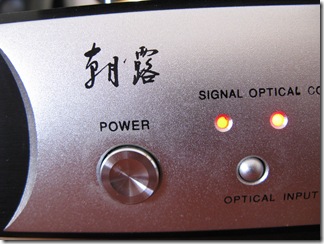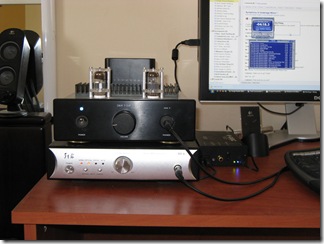 In the previous installment I have first experimented with rolling the tubes in my headphone amp, and first introduced an external DAC into one of my audio setups. Replacing the Electro Harmonix 6922EH tubes with a pair of matched JAN-Sylavnia 7308 tubes bought me a significant improvement in soundstage and resolution, and adding a Musical Fidelity V-DAC into the mix resulted in even better resolution at the expense of reduced imaging:
In the previous installment I have first experimented with rolling the tubes in my headphone amp, and first introduced an external DAC into one of my audio setups. Replacing the Electro Harmonix 6922EH tubes with a pair of matched JAN-Sylavnia 7308 tubes bought me a significant improvement in soundstage and resolution, and adding a Musical Fidelity V-DAC into the mix resulted in even better resolution at the expense of reduced imaging:
“… the V-DAC features significantly improved accuracy and resolution, and more and more often I’ve been rewinding tracks just to make sure that, yes, I wasn’t imagining, I really have never heard this or that detail before… In fact, the only disadvantage is in a certain change in the soundstage, as though the stereo separation grew just a littler wider than I’d like. Don’t get me wrong, the soundstage is huge and imaging is terrific, but it sometimes seems to be that sounds tend to cluster a little closer to the extremes of the soundstage than they should.”
When that upgrade was concluded I was left with an unfulfilled sense of curiosity. The first tube upgrade was a huge success, and the new DAC added the detail I was missing with the original setup, but I was not entirely happy with the difference in soundstage. Along with the 7308 tubes I bought a pair of Mullard E88CC; from what I’ve read on the tube I predicted that it would improve the soundstage, a theory which immediately I put to the test.

Great success! The 7308 tubes were such a huge step up, I did not expect to be so well-rewarded the second time around. The soundstage not only “deflated” to more natural-sounding positioning, but it also deepened (i.e. became more three-dimensional). Instrument articulation has improved dramatically: buzzing of metallic strings can be heard distinctly on decent recordings, bass has deepened remarkably and the sense of air around instruments can be absolutely mind-boggling. Even the noise floor dropped a few decibels. The improvement was so pronounced I now have a renewed desire to test additional tube amps, such as the Little Dot Mk IV SE or DarkVoice 336 SE. I’ll certainly post my experiences if I manage to get my hands on one of these…
Finally content with my primary setup (which I primarily use at work), I have turned my attention to the secondary setup at home. At that point the setup consisted of an onboard ALC889A codec, connected to an Aqua Mini-Head via a generic analog interconnect, this in turn connected to ‘03 Beyerdynamic DT880 cans. In my previous post I had failed to mention that I did test the ‘05 edition DT880s with the 7308 tubes and found the new edition to be a downgrade: slightly better midbass marred by a muddy soundstage, flat treble (without the sense of “air” I’ve begun to associate with tube-based amplification) and a generally degraded experience than with the older edition. At that point I had almost put my original setup up for sale in its entirety, but decided to hold on to it for a few more experiments before I let it go. I took the opportunity to test those cans with the upgraded Mullard tubes, but am sad to report that no new synergy is to be found in that direction, and throwing the V-DAC into the mix did not result in any improvement either.
 As it happens, an opportunity presented itself to buy an upgraded Zhaolu D2.5 DAC for a very good price, and after arranging to loan it for a few days I’ve had the chance to try out some interesting new combinations. The Zhaolu (apparently pronounced chow-loo) D2.5 is a modular DAC that, at a cost of $215, is widely considered as one of the finest and most customizable value-priced DACs on the market. There are a lot of aftermarket upgrades available for the device, and it’s offered with a headphone amplifier module for an extra $55. The device is based off of a CS4398 chip, and my particular unit comes with upgraded National LM4562 opamps. The unit is extremely large (24cm x 30cm x 5.5cm – about the same surface area as the G&W amp!) and surprisingly heavy. Build quality is fairly mediocre: the markings on the front tend to easily wear off and the volume control produces an audible distortion when adjusted. From a usability perspective the unit is decent but does have a couple of minor annoyances, specifically the need to select the optical channel every time I turn it on and an annoying blinking “mute” indicator when there is no active signal from the computer.
As it happens, an opportunity presented itself to buy an upgraded Zhaolu D2.5 DAC for a very good price, and after arranging to loan it for a few days I’ve had the chance to try out some interesting new combinations. The Zhaolu (apparently pronounced chow-loo) D2.5 is a modular DAC that, at a cost of $215, is widely considered as one of the finest and most customizable value-priced DACs on the market. There are a lot of aftermarket upgrades available for the device, and it’s offered with a headphone amplifier module for an extra $55. The device is based off of a CS4398 chip, and my particular unit comes with upgraded National LM4562 opamps. The unit is extremely large (24cm x 30cm x 5.5cm – about the same surface area as the G&W amp!) and surprisingly heavy. Build quality is fairly mediocre: the markings on the front tend to easily wear off and the volume control produces an audible distortion when adjusted. From a usability perspective the unit is decent but does have a couple of minor annoyances, specifically the need to select the optical channel every time I turn it on and an annoying blinking “mute” indicator when there is no active signal from the computer.
The D2.5 has only S/PDIF and TOSLINK inputs, and I did not experiment with the V-DAC’s optical input to draw a comparison, so this is not a direct apples to apples comparison; that said, I connected the D2.5 to my desktop via TOSLINK, connected it via the preamp output to the G&W amp and started with the ‘03 edition Beyerdynamic DT880 headphones.
The initial impression was severely disappointing: while the resolution was incredible, the sound had lost all warmth and the soundstage had lost all depth. Just to put things in perspective: this sounded significantly worse than with a straight analogue connection from my computer at work. I figured that since the integrated headphone amp in the D2.5 was designed along with the DAC the combination would probably work better; unfortunately, this resulted in an even flatter soundstage, and imaging suffered as well.
 At this point I had almost given up on the DAC, but decided to switch back to the G&W amp and try out the ‘05 edition DT880s. This resulted in a markedly improved sound in comparison with the V-DAC and analogue connection; the sound gained some warmth, the soundstage expanded significantly and imaging improved as well. This is still a far cry from the ‘03 edition DT880 and V-DAC combination, but I could see how the Zhaolu DAC would benefit the cans if it was paired with the right amp.
At this point I had almost given up on the DAC, but decided to switch back to the G&W amp and try out the ‘05 edition DT880s. This resulted in a markedly improved sound in comparison with the V-DAC and analogue connection; the sound gained some warmth, the soundstage expanded significantly and imaging improved as well. This is still a far cry from the ‘03 edition DT880 and V-DAC combination, but I could see how the Zhaolu DAC would benefit the cans if it was paired with the right amp.
While a definite improvement over the previous anemic combination, the results were still not satisfying. I briefly tried running the D2.5 and V-DAC through the Aqua amp but was not overly impressed; either the Mini-Head is not a good match for the DT880s (it was supposedly designed around the Sennheiser HD600) or it simply isn’t a very good amp. As an aside, in both cases the ‘03 edition sounded better to my ears than the ‘05.
Having tried nearly every combination of equipment at my disposal I nearly gave up at this point, but for the sake of completeness decided to try out the D2.5 and its integrated headphone amp with the ‘05 DT880s. To my surprise, this combination is a winner: amazingly revealing, detailed sound combined with robust imaging and a wide (albeit not as deep as I’d like) soundstage. While not as musical as my primary system (G&W amp, Mullard tubes, V-DAC), the Zhaolu D2.5 provides better resolution and an experience that’s nearly as engaging as that combination for less than a fourth of the cost. Value for the money indeed! If you can find one of these units, I definitely suggest giving it a try; just make sure to test it first as it’s apparently quite finicky with regards to its partners. For my part, the Zhaolu D2.5 has permanently replaced the Aqua Mini-Head amp in my home setup; this, in turn, went to my brother who is quite pleased with it driving ‘03 DT880s via a Creative X-Fi sound card.
Visit my Flickr account for more photos